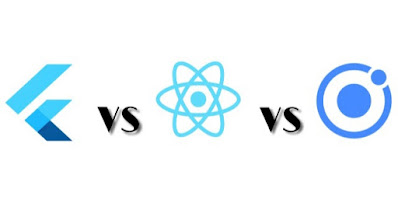Flutter vs. React Native vs. Ionic: Modern-Day Cross-Platform App Development
Tools
Flutter, React Native and Ionic are some powerful
Modern-Day Cross-Platform App Development Tools
that allows us to build iOS and Android apps with one programming language and
with one project codebase. The above three are probably the biggest
competitors to each other. But they have differences among themselves.
Now let's see how each of these works and what differences they have among
themselves based on given parameters :
Programming language :
Flutter uses Flutter framework and Dart language which
is developed by Google. Dart is a object-oriented,
class-based, garbage-collected language with C-style syntax,
client-optimized programming language for apps on multiple platforms and it
is used to build mobile, desktop, server, and web applications. Whereas
React Native uses React library and JavaScript to deliver a
native experience on iOS and Android. While Ionic makes the best use
of web technologies like HTML, CSS, and JavaScript and requires a Cordova
plugin to wrap the applications in native containers.
Working and execution of code :
The major difference among these is in Flutter you get compiled
native apps, so we get real native apps compiled for the target platforms.
For React Native, that's pretty much the same but partly compiled
here because the apps are compiled to native apps but there are also parts
in our JavaScript code
which is actually not compiled but which is basically enclosed in the native
app and runs as JavaScript
in the native app, instead of as compiled code and that's different for
Flutter, there
all the code is compiled and runs as native machine code and for
Ionic, nothing is compiled. There we actually have a web app which is
wrapped inside a native app, so we still get a native
app which we can publish to the app stores but it's just a wrapper around
our web app.
Performance :
This is one of the deciding parameter to choose the best tool.
Flutter uses Dart which is new and gradually improving.
If we talk about UI & UX flutter offer high-quality, native-like
experiences which is preferred by the UI & UX developers.
React Native lets us build an application that provides native look,
it is compiled to the native iOS component for iOS and to the native Android
components for Android, which means we have less customization
possibilities.
Ionic is different than other frameworks as it uses web technologies
like HTML, CSS, and JavaScript to create cross-platform apps. In
Ionic we can use normal web technologies and if you're a web
developer, it's particularly easy to create such apps and you can use all
your normal web development skills to build
cross-platform apps there.
Popularity :
It is very obvious that React Native is more popular than the other
two as many tech giants like Facebook, Instagram, Tesla, Uber, Walmart
etc. are using it for their environment.
On the other side, Ionic is very popular among web and mobile app
developers. It is used by MarketWatch, Pacifica, Sworkit, Nationwide, and
many more.
Flutter is comparably new but it has gained popularity in very
less time. It is used by Alibaba, Hamilton Musical, Greentea, Google Ads,
and so on.
Which Framework You Should Use And Why ?
Flutter is developed by Google, React Native is
developed by Facebook and Ionic is developed by a company
which is called Drift Co. and therefore, they all have
big companies backing them, especially React Native and
Flutter of course but also the Ionic is earning its money
with the Ionic framework. Regarding the future, all three should
be very stable and under active development for a long time, so that
shouldn't influence your choice. What should influence your choice
then?
Well for Flutter, there you have the great advantage that you
have real native apps, so you get great performance, no web view wrapped
app which automatically has a bit worse performance because of that
wrapping, instead you have machine code that gives you a great
performance and because Flutter controls every pixel on
the screen, you also have a high flexibility and lot of control over
your app.
Ionic has a easy learning curve due to web technologies while
Flutter requires developers learning Dart to build apps.
Also, Ionic is not a preferable choice for intense graphical apps
or game development because of wrapper plugins that cause performance
issues sometimes. Flutter is new and gradually growing with the
support from best developers of Google and the community.
Finally we can say that all these Modern-Day Cross-Platform App Development Tools
are best at their own and will be under the active development many years.



👌👌👌👌
ReplyDeleteThank you 🙂
DeleteVery nice information about flutter and many more
ReplyDeleteThank you 🙂
DeleteWau good job dost, keep it up
ReplyDeleteThank you 🙂
DeleteVery good presentation and explanation
ReplyDeleteThank you 🙂
DeleteInformative
ReplyDeleteThank you 🙂
DeleteNice Explanation
ReplyDeleteThankyou
Delete